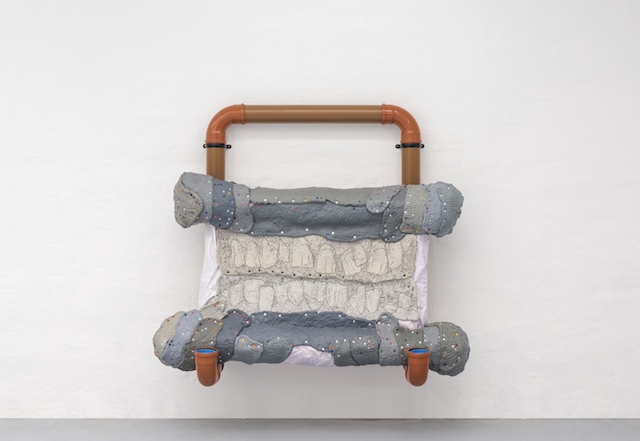The title of Sebastian Jefford’s show begs for explication. Procrustes, a bandit from Greek mythology, stretched his victims (or cut off their legs) in order that they would fit his bed. For the paranoid exhibition reviewer, ‘procrustean flatulence’ might be read as a provocative metaphor for the reviewing process itself, suggesting that writing about art is all so much trapped wind produced under tortuous circumstances. But more largely, this recent Royal Academy graduate’s pointedly unconventional mixture of aesthetics – sculpture plus a fictional narrative – suggests Jefford would prefer that we adapt ourselves and our preconceptions to his work, rather than vice versa.
His show takes its cue from a short story written by the artist and titled ‘In the City’. In this city of Jefford’s invention, the law states that if a citizen ‘needed to enter any dwelling or building… [they were] required to witness its entire construction, beginning to end’. More disturbingly, the artist-author adds that if said person wanted to enter a building constructed after their birth, they ‘would have to make an application to the council to have it demolished… [and] then be required to witness the entire process of its reconstruction before they could enter’. We know this because a flatscreen suspended from the ceiling approximately in the centre of the space shows a video titled after said story (all works 2018), in which Jefford’s tale is narrated by a synthesised voice that sounds Welsh. (Jefford, who is in his mid-twenties, hails from Swansea.) We hear that the son of a city minister has rebelled against the building regulations and, in a bizarre state of independence, chosen to live, Gregor Schneider-style, in a 30cm cavity between two walls. On video, the cityscape is scanned from left to right – we see threatening night-visions of the city with its wire fencing, its dimly lit apartment windows.
Meanwhile, mounted on the gallery’s walls is a sequence of odd assemblages. Some have bits of clay incised to look like giant mouthfuls of rotting teeth, and sit cradled by brown plastic pipes – as with Sometimes I can’t tell if you’re my world or my Wilson. These mouths, the press release suggests, might be imagined as the maw where the ruins of the city are ingested. Another construction, staying with the gastrointestinal theme, is called Borborygmatic Hearsay, perhaps so named to conjure the gurglings and rumblings of brickwork as it is digested. Titles are important to Jefford – his are ludic but somewhat strained, such as Aggressively Indeterminate Biscuit, for example. Then there’s the wall-mounted Lovely Pungent, a parallelogram construction where green and orange pins tack down flattened pieces of clay, on whose surface are drawn what appear to be two sleeping marsupials. The rectangular Dandruff Castle is inscribed with another animal – possibly breastfeeding – and looks as if it were blackened by tar and unearthed from a bog.
On the floor of the gallery, and propped against the walls, are several giant keys, Jefford’s Buried Earth Motors. His sculptural forms are well constructed: you want to pick them up, use them. In an interview with the website Young Artists in Conversation, he has discussed his pleasure in contrasting hard and soft, and accordingly there’s reference here to Claes Oldenburg’s gargantuan constructions.
Overall, though, Jefford’s installation – which, it should be said, scans as somewhat muddled – mixes Ed Kienholz’s Pop-flavoured pessimism with the fiction of Edgar Allan Poe, a hell in which – in the artist’s story – the minister’s son’s cadaver is discovered by the smell of decomposition. Such addled musings on architecture seem somewhat appropriate at Gianni Manhattan, which is located only a few hundred metres from the chaotic construction experiments of Friedensreich Hundertwasser, as they chime with Hundertwasser’s advocacy of natural forms of decay. Also nearby is the Haus Wittgenstein, designed (in part) by the eponymous philosopher, who here drove his coworkers to exhaustion with antiprocrustean demands such as raising the ceilings by 30mm. Similarly, Jefford’s conceptual crosscurrents call for more room, albeit in cognitive terms. He asks that, figuratively speaking, we don’t cut off our legs to fit the bed but make it longer instead.
Sebastian Jefford: Procrustean Flatulence at Gianni Manhattan, Vienna, 10 March – 28 April
From the May 2018 issue of ArtReview
